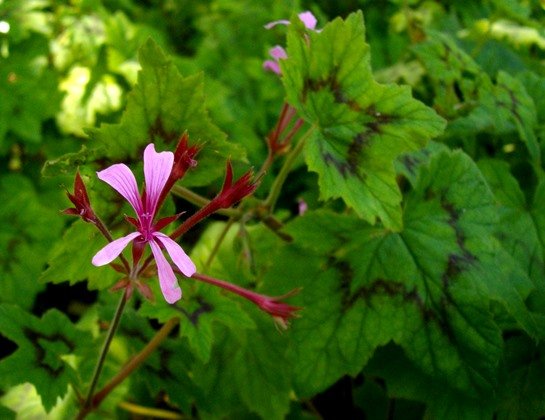Pelargonium

Author: Ivan Lätti
Photographer: Thabo Maphisa
Pelargonium is a large genus in the Geraniaceae family of flowering plants. The species ranges from shrubs and stemless geophytes to scramblers, climbers and herbs, also some annuals. The generic name, Pelargonium, is derived from the Greek word pelargos meaning stork. Pelargonium fruits generally resemble the beak of a stork.
The erect or decumbent plant stems are mostly herbaceous, but some are woody, succulent, sticky, hairy or retaining old petioles or spine-like stipules.
The usually stalked Pelargonium leaves are alternate, ranging from simple with entire margins, to much dissected or compound forms, sometimes changing shape with age within a species as different tissue types play roles at different phases in development and appearance. The leaves are usually aromatic and hairy, often glandular.
The inflorescence is a pseudo-umbel, varying widely in the number of flowers borne. Peduncles vary in length, involucral bracts occur. There is a floral tube (hypanthium) present at the base of every flower. This tube includes a nectar-bearing container or spur, fused with the pedicel below and opening into the base of the upper sepal (for delivering its nectar). The base of the floral tube is often thickened.
There are five sepals, joined at the base, sometimes with reflexed tips. The petals are usually five, sometimes four and rarely two. The upper (posterior) pair is present throughout, the lower (anterior) ones reducing by one or absent.
Ten stamens occur in each flower, joined at the base. From two to seven of them are fertile. The anther attaches at its back to the filament.
The ovary is positioned on a raised platform. It has five lobes corresponding to five locules that each contains two ovules. The style varies in length. It ends in five reflexed, thread-like stigmas.
Each single-seeded fruit tapers from tip to base, ending in a spirally twisted awn. The seeds are oblong to ovoid.
There are about 270 Pelargonium species on earth, 219 of them found in southern Africa, mostly the Western Cape. The rest occur in Africa, Asia, Australia, New Zealand and some Indian Ocean and Pacific islands including Madagascar.
Pelargoniums are often called geranium, a related genus within the same family of Geraniaceae. A true geranium has five identical petals. Flowers that are radially symmetrical (like daisies or geraniums) are called actinomorphic, whilst flowers with irregular petal arrangement or laterally symmetrical are called zygomorphic (like pelargoniums or orchids).
The plant in picture is Pelargonium alchemilloides (Leistner, (Ed.), 2000; Manning, 2009).

